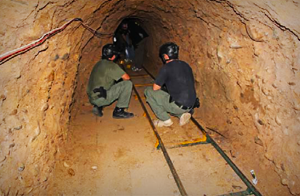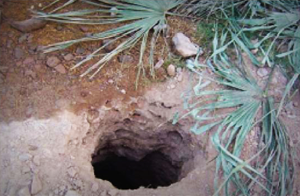Here are a couple of problems: in each case a hostile force is using a secret device to advance its nefarious cause. In each case an English-speaking government wants to do something about it.
These are the challenges:
- During World War II the Germans had (for the time) a high-tech way to mask its military messages; they did so through the Enigma Code.
- Right now the Mexican drug cartels are using tunnels under the border to mask its delivery of illegal drugs, as well as some illegal aliens, into the United States.
The results of the two governments' efforts:

- The Brits quickly (and secretly) broke the code and handled their responses to the coded messages in such a way as to shorten the war, some say by years.
- The tunnels continue to plague our border forces, and sometimes are found within a mile or less of our high-tech, heavily manned, 24-7 ports of entry.
What follows may be a bit over-generalized, but the Brits (between the fall of France in 1940 and the invasion of Russia the following summer) felt absolutely alone in the world, and were facing a ruthless and highly successful Nazi war machine. They were super-motivated, desperate, and willing to try anything. And Enigma was a major part of the problem.
The Brits assembled a set of very bright people from a number of disciplines: some eccentric, some with absolutely no military backgrounds; placed them all together in a nice old country estate, Bletchley Park; gave them both adequate resources and freedom of action and thought; and told them to solve the problem — which they did.
The situations, of course, are not totally comparable; The Department of Homeland Security has numerous challenges, and the tunnels are fairly low on the list of priorities. But DHS seems to figure it can handle the matter in its usual, pedestrian, by-the-book way.
This thinking-within-the-box approach is dramatically illustrated in the recent report of the DHS Office of Inspector General (OIG) entitled "CBP's Strategy to Address Illicit Cross-Border Tunnels". CBP being Customs and Border Protection, the DHS entity that includes both the Border Patrol and the ports-of-entry operations.

OIG's study concludes that the Border Patrol and ICE agents, both within DHS, should agree on objectives and approaches; that DHS should conduct a study of "tunnel detection capabilities through existing processes and procedures"; that DHS should "complete the Concept of Operations document"; and that DHS should "designate an authority to provide leadership … prior to approving the program."
As Senator Diane Feinstein (D-Calif.) said, in connection with another sleepy part of DHS (the unit dealing with visa mills) at a Senate hearing this past summer: "Process, process, process! And no action", which CIS reported in an earlier blog.
What I would suggest, in addition to the OIG's sensible, if mundane, recommendations noted above, is that OIG, or some other agency, convene a three-day meeting in a Nogales, Ariz., motel (near where many of the tunnels are). It would be a brainstorming session, and would include both DHS staff and a dozen or so people with these talents:
- A retired senior Border Patrol officer or two;
- The ranking scientific officer of the Israeli government dealing with Gaza tunnels;
- An uncorrupted, retired, ranking Mexican law enforcement officer, if one can be found;
- Similarly, a reformed convict who helped plan and build one of the cartels' tunnels;
- A mining engineer and the supervisor of one of those mine-rescue operations where they had to drill a hole to get to the trapped miners in a not-completely known location, as in Chile recently;
- A civil engineer familiar with the drainage and sewer pipes, often used by smugglers, that run under Nogales and some other border towns;
- A soil scientist, familiar with the border region;
- A criminologist familiar with the Mexican drug trade;
- A medieval warfare expert, probably from Europe, who knows all about the ways armies used to dig tunnels under castle walls, and how those sapping operations were dealt with by the people inside the castle;
- Two veterans of the Vietnam war that dealt with the Viet Cong's massive use of tunnels in that war, one from our side, and one from the other;
- Some people from NASA who deal with remote sensing operations;
- An archeologist experienced with the electronic devices that indicate, from the surface, whether or not the earth has been disturbed under the surface;
- A non-DHS spy master who will discuss how to hire people on the other side of the line to observe the by-products of the tunnel-digging activities, which, by definition, produce much dirt and rocks that need to be moved somewhere; with the whole session presided over by
- A skilled facilitator, preferably a verbal, self-confident, non-overbearing polymath.
I submit that the collection of skills listed above would produce something much more useful than the 11-page OIG report (padded with interesting photos and less interesting summaries, and cover letters and appendices), which was produced by a team with these skills:
- A director
- An audit manager
- Two senior auditors
- Two auditors
- A program analyst
- A communications analyst, and
- A referencer (terrible word)
These skills are listed on p. 18 of the OIG report.
As someone who has often worked as a one-person research entity, I get a kick out of an 11-page document written by a nine-person team; let's see, that is exactly 1.222 pages per team member.
Why the world's richest, most technologically skilled nation should continue to be plagued by tunneling operations which still use many approaches left over from the Middle Ages is a puzzle that perhaps the proposed, oddly-assorted collection of experts could solve.
The OIG report, by the way, offers no such proposal.
